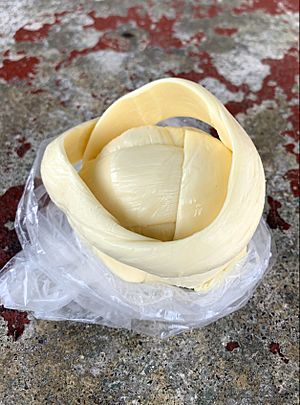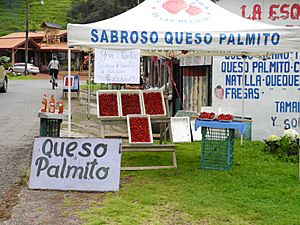Palmito cheese facts for kids
Quick facts for kids Palmito cheese |
|
|---|---|

Palmito cheese
|
|
| Country of origin | Costa Rica |
| Source of milk | Cow, usually Holestein, Jersey, or a crossbreed |
| Pasteurised | Sometimes |
| Texture | Semi-hard |
| Fat content | 16-24% |
Palmito cheese (Spanish: Queso palmito) is a popular fresh cheese from Costa Rica. It looks a bit like a knotted ball of string cheese. People say it's light, a little salty, and very stringy. Its texture is similar to mozzarella cheese. It's also like Oaxaca cheese from Mexico. This cheese is a type of stretched-curd cheese. It's made using a special method called pasta filata. Many believe that Italian immigrants brought this cheese-making idea to Costa Rica.
In 2007, at a special event in Zarcero, local cheese makers created a giant ball of palmito cheese. It weighed an amazing 132 kilograms!
Contents
Where Did Palmito Cheese Come From?
Palmito cheese first came from a place called Cutris. This area is in San Carlos, which is a big dairy farming region in Costa Rica. At first, it was called queso arrollado, which means "rolled cheese." It wasn't very popular back then.
Later, the cheese production moved to La Palmito de Naranjo. That's when it became known as queso palmito. The word palmito means heart of palm. The cheese's shape and look remind people of a heart of palm.
All About Dairy in Costa Rica

Dairy farming has grown a lot in Costa Rica over the past few decades. About 95% of the cows in the country are Holstein or Jersey. Some are also a mix of these two types. From 2005 to 2009, milk production increased quite a bit.
In Costa Rica, people eat about 8.4 kilograms of cheese per person each year. Most of this cheese, about 95%, is fresh cheese. Only a small part, about 5%, is aged cheese. This is a common trend in Central America. Costa Rica even has an official rule for cheese. It was set in 1988 and gives definitions and rules for different cheeses.
Where Palmito Cheese is Made
Making cheese by hand is very important in Costa Rica. Turrialba, Bagaces, and Palmito are the three main cheeses made there. They all use something called rennet to make the milk solids (curd) clump together. But they are different in how they treat the curd. This changes how much moisture, fat, and salt are in the final cheese.
Palmito cheese is mostly made in the Zarcero area, which is in the province of Alajuela. You can also find it made in other regions like San Carlos and Santa María de Pocosol. It's sold in many places. You can buy it at supermarkets, shops, roadside stands, and farmers markets.
What Palmito Cheese is Like
Palmito cheese is a type of string cheese. It has a shiny surface and no hard outer layer (rind). It's a fresh cheese that is a bit acidic. It's made with fresh whole cow's milk. This cheese has about 16% to 24% fat. It also has 46% to 58% moisture. It's known as a medium-fat, semi-hard cheese. It's quite firm and can be a bit hard to cut. The color of the cheese is usually creamy white or slightly yellow.
How Palmito Cheese is Made
A lot of Palmito cheese is made by small producers using traditional methods.
First, fresh milk is collected from cows. The milk is then gently heated to about 50 to 55 degrees Celsius for 30 minutes. It is stirred constantly during this time. This process is called pasteurization, and it makes the milk safe to use. After heating, the milk is cooled down to about 35 to 37 degrees Celsius.
Next, the milk goes through fermentation and curdling. This is when the milk starts to thicken and form curds. The curds are then cut into smaller pieces. After cutting, the curds rest for about 45 to 60 minutes. Then, the liquid part, called whey, is drained away.
The remaining curds are then kneaded. After kneading, they are shaped by hand. They are rolled and then cooled in cold water. This gives the cheese its special shape. Finally, the cheese is rolled again, salted, and molded. It is then packaged and stored, ready to be enjoyed!

